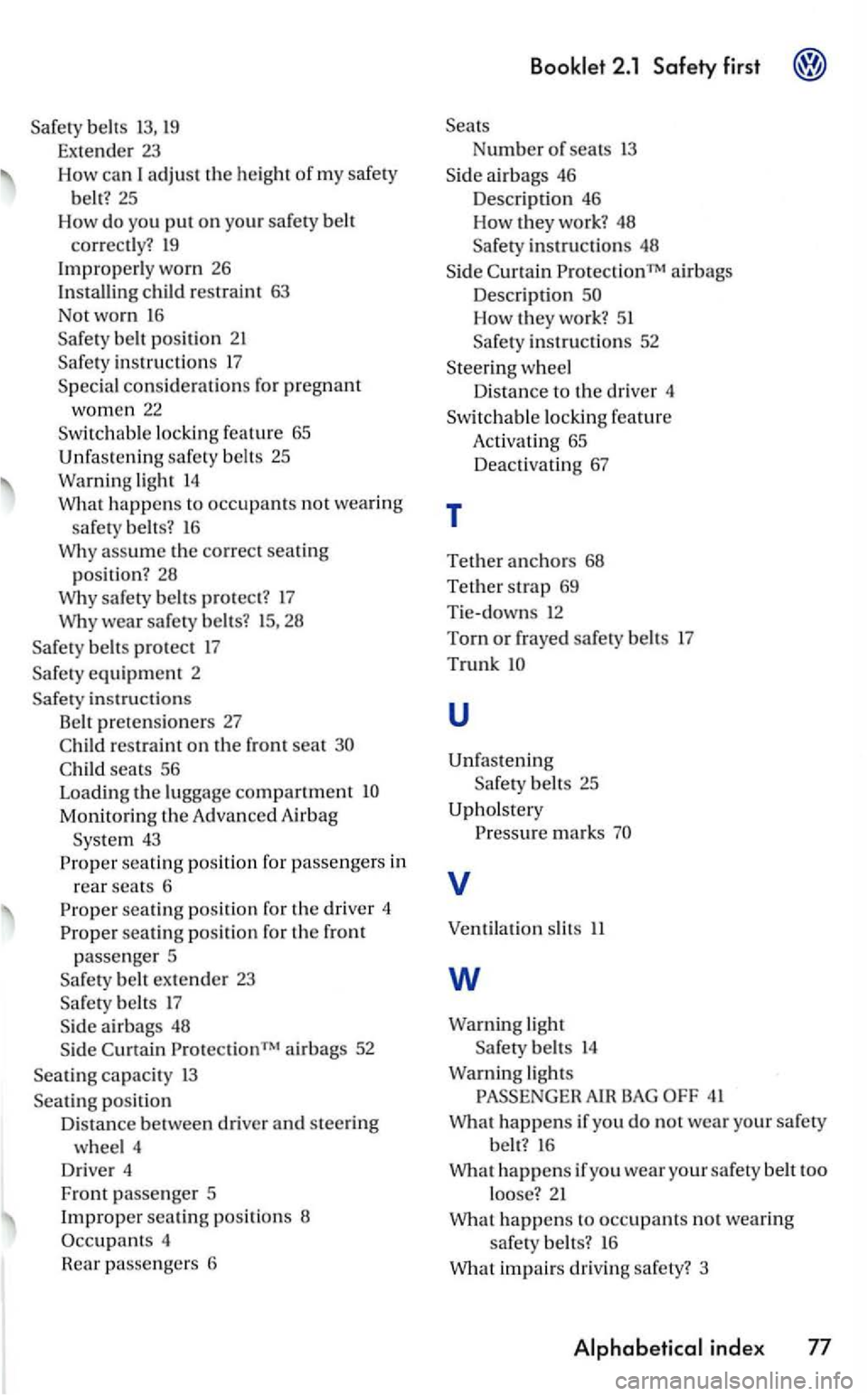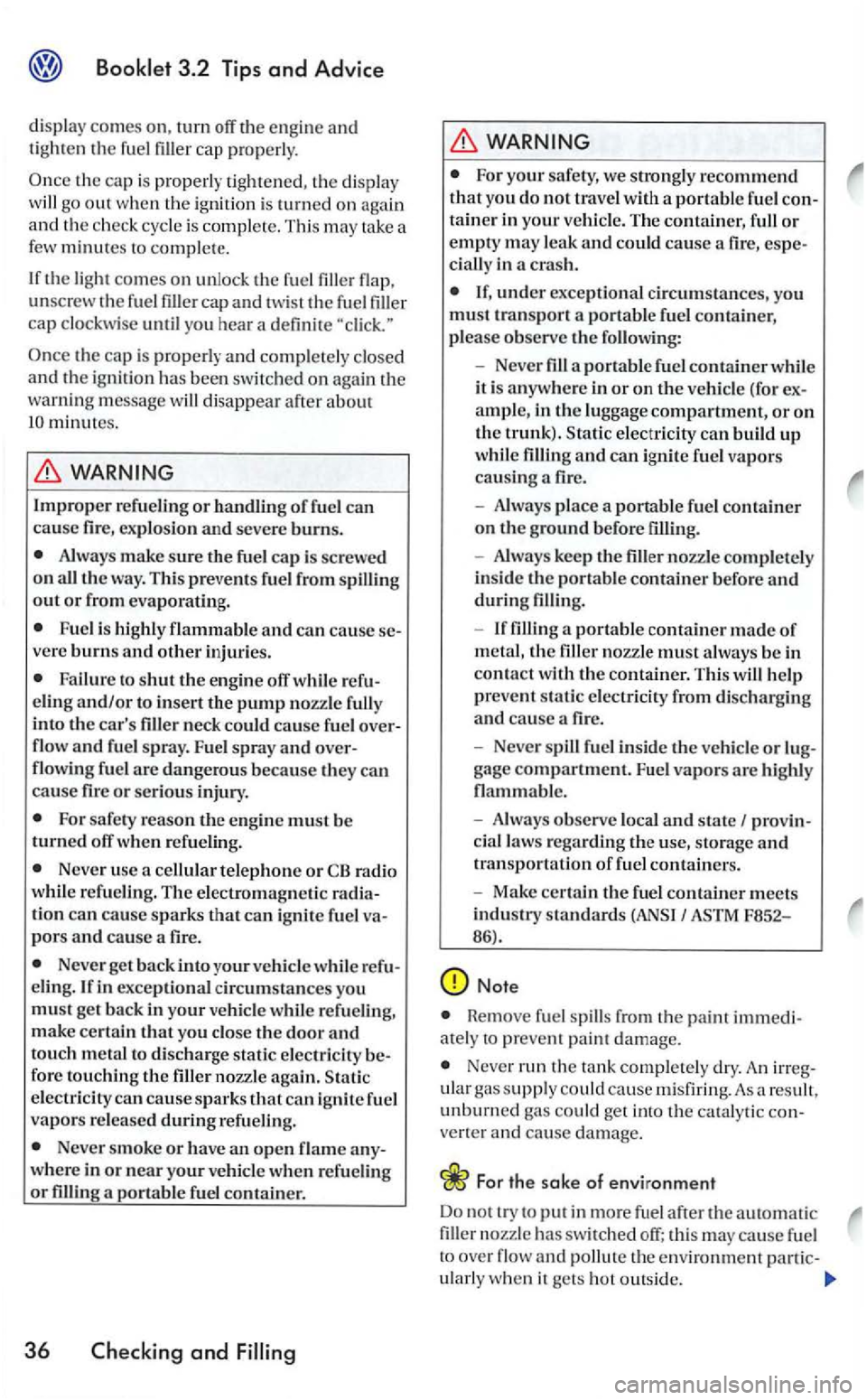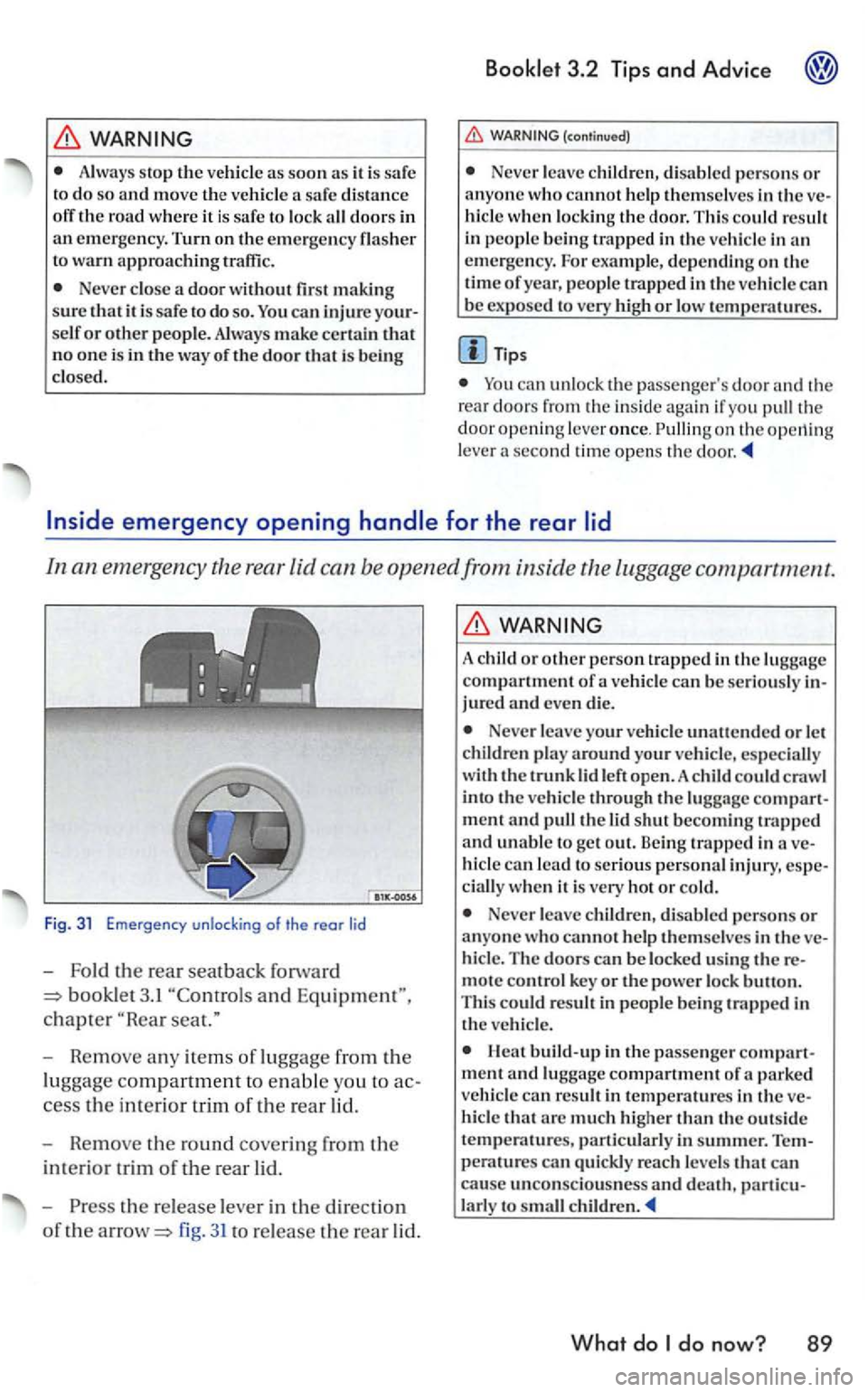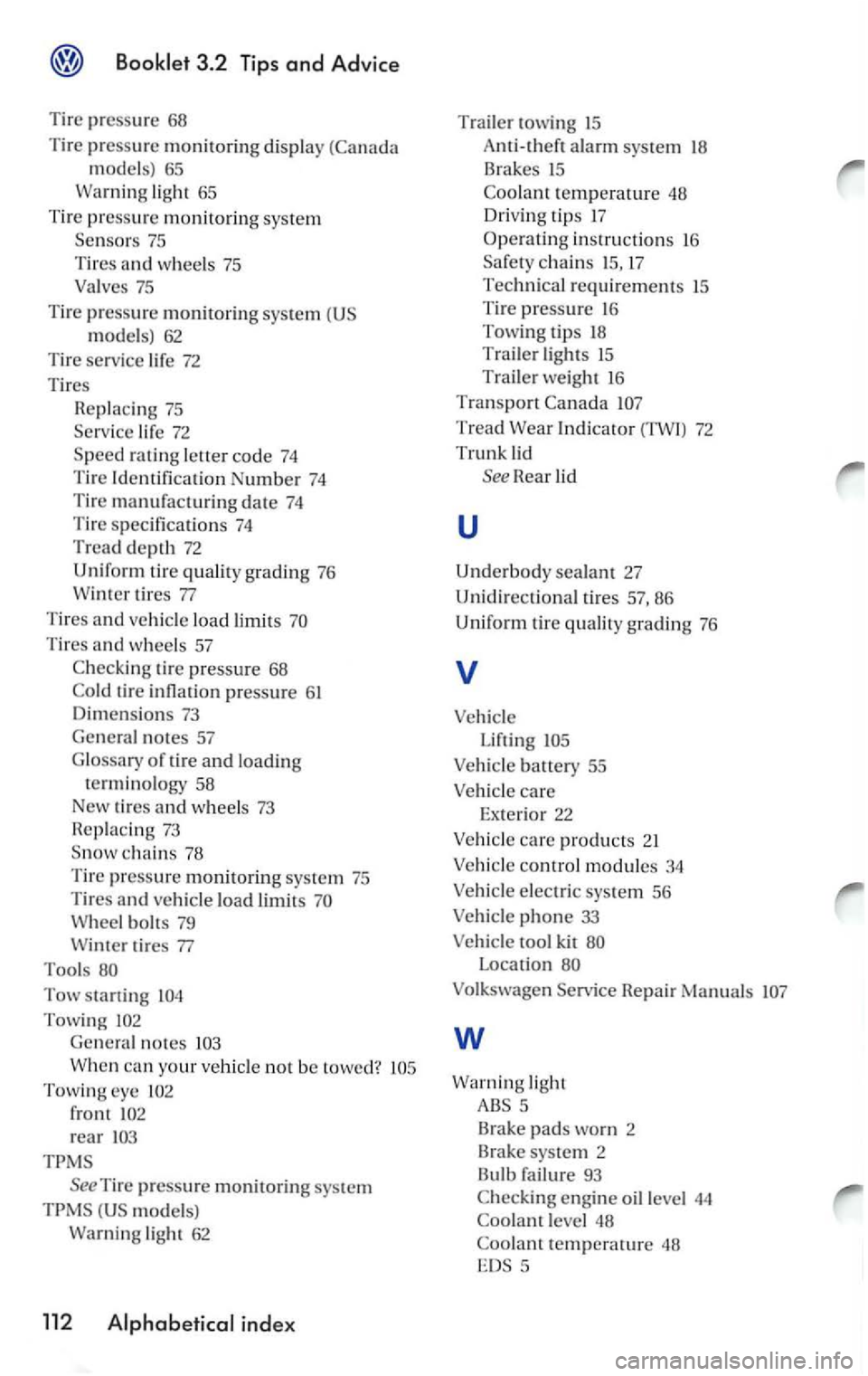2008 VOLKSWAGEN GOLF trunk
[x] Cancel search: trunkPage 16 of 444

Tank
the tank 3.2: 35
Fuel gauge 3.1:
fuel filler flap 3.2: 35
Technic al modifications 3.2:
32
Tether anchors 2.1:68
Tether strap 2.1:
69
Threaded rim ring 3.2: 57
down hooks 3.1:
Tie-dow ns 2.1: 12
Tire pressure 3.2: 68
Tir e pressure monitorin g disp lay
mode ls) 3.2: 65
Warn ing 3.2: 65
T i
re pres sure monitoring sys tem
3.2: 75
Tires and wheels 3.2: 75
Valves 3.2: 75
Tire pressure monitoring system
models) 3.2 : 62
Tires
Repla cing 3.2:
75
life 3.2:72
rating le tter code 3.2: 74 Tire Identification Number 3.2: 74
Tire manufacturing date 3.2: 74
Tire specifications 3.2: 74
Tread
depth 3.2:72
tire pressure 3.2: 68 tire inflation pressure 3.2: 61 Dimensions 3.2: 73
General notes 3.2: 57
Glossary of tire and loading terminology 3.2: 58
New tires
and wheels 3.2: 73 Replaci ng 3.2: 73
ch ai.ns 3.2: 78
Tir e pressure monitoring system 3.2: 75
Tires and vehic le load lim its 3.2: Whee l bolts 3.2: 79
Winter tires 3.2:77
Tir e serv i
ce life 3.2:72
Tool s 3.2:
Torn or fra yed safe ty belts 2.1: 17
Towing 3.2:
General notes 3.2: 103
When can your vehicle not be
t owed? 3.2:
Towing eye 3.2:
See Tire pre ss ure monitoring system
model s)
Warning
light 3.2: 62
Trail er towing 3.2: 15
Anti-theft alarm system 3.2: 18
Brake s 3.2: 15
instructions 3.2 : 16
3.2:
Transporting long items 3.1: 63
Tread Wear Indi cato r
Trunk lid 3.1: 35
See also Rear lid
Turn signa l and high beam lever 3.1:46
Turn signal s 3.1: 46
Warning light 3
.1: 46
u
Underbody sealant 3.2: 27
Unfast ening belts 2.1: 25
Unidirectional tires 3.2:57, 86
tir e qual ity grading 3.2: 76
Unpleasant odor 3.1: 83
Uphol stery
Key word s 13
Page 165 of 444

belts 13, 19
Extender 23
How can I adjust the heigh t o f my safery
belt? 25
How
do you put on you r safery belt
correct l
y? 19
Improperly worn 26
Installing child restraint 63
Not worn
16
belt position 21
instructio ns 17
Specia l consid erations for pregnant
women 22
Switc hab le locki ng feature 65
Unfa stening safe ty belt s 25
Warning light
14 What happen s to occupants not wearing
safety
belt s? 16 Why assume the co rrect seatin g
position? 28
W hy safery belts protec t? 17
Why wear safery belts? 15, 28
belts protect 17
Monitoring the Advanced Airbag
43
seatin g positi on for the driver 4
seating position for the front
passenger 5
belt extender 23
Curtain airbags 52
Seating capacity 13
Sea ting position Distance between driver and steering
wheel 4
Driver 4
Front
passenger 5
Improper seat in g positi on s
4
Rear
passe ngers 6
air bags 46
Description 46
Ho w
they work?
in structio n s 48
airbags
Desc ripti
on
How they work? 5 1
instructions 52
Steer ing w hee l
Distance
to the driver 4
Sw itchable locking f
eature
Activating 65
Deactivating 67
T
Tether anchors 68
T
ether strap 69
Tie -
downs 12
Torn or f rayed safety bel ts 1 7
Trunk
u
Unfasten ing
belts 25
Upholstery
v
Ventil ation slit s ll
w
Wa rning light
belts 14
Wa rnin g lights
Page 312 of 444

Booklet 3.2 Tips and Advice
display come s on, turn off the engine and
t ig ht en th e fuel filler cap prop erly.
the cap is prop erly and comple te ly closed
a nd the ig nition has been switc h ed on agai n th e
wa rning message will disappear after abo ut
Improper refueling or handling of fuel can
cause fire, e xplosion and severe burns.
Always make sure the fuel cap is sc rewed
o n
Fuel is hi ghly flammable and can cause
eling and/or to insert the pump nozzle fully
into the filler neck could cause fuel flow and fuel s pray. Fuel spray and flowing fuel are dangerou s beca use they can cause fire or serious injury.
For safe ty reason engine must be turned off when refueling .
Never use a ce llular te lephon e or radio w hile refueling. The electrom ag ne ti c tion can caus e sp arks that can ig nite fuel pors and cause a fire .
Never get back into your ve hicl e while eling. If in exceptional circumstances you must ge t back in your vehicl e while refu eling, make ce rtain that you close door and touch metal to di scharge stati c electricity for e tou chin g the filler nozzle again. electricity can cause sparks can ignit e fuel
vapors released during refuelin g.
Never smoke or h ave an open flame where in or near you r vehicle when refu elin g or fillin g a portable fuel container.
36
For your safety, we strongl y recommend that you do not travel with a portable fuel
cially in cras h.
If , under exceptional circum stances, you must transport a portable fuel co ntain er,
pl ease observe the foUowing:
- Never
fill a portable fuel container while
it is anywhere in or on the ve hicl e (for ampl e, in the lu ggage compartment, or on the trunk). electricity can build up while filling and can ig nite fuel vapors
ca usin g a fire.
- Always pl
ace a portabl e fuel container on ground b efor e
-Alway s keep the filler nozz le co mplet ely
in side the portab le container b efo re and during fillin g.
- If filling a
portable container made of
metal , the filler nozzle must a lway s be in
contact with the container. This will help prevent static e lec tricity from disc ha rgin g and ca use a fire.
- Never
cial laws regarding the use, storage and transporta tion of fuel containers .
- Make certain
the fuel container meets
industry standa rd s F852-86).
Remove fu e l spills f rom the paint ately to prevent pai nt dam age.
Never run the tank completel y dry. An ular gas supply co uld cause misfiring. A s res ult ,
u n burn ed ga s co uld get into the ca ta lytic vener a nd cause damage .
For the sake of environm ent
Do no t try to p ut in more fuel after the au to m atic fille r no zzle has switched off; this may ca use fuel to over flow and pollut e th e enviro nment parti c-
ularl y when it ge ts hot outside.
Page 365 of 444

WARNING
Alwa ys sto p the as soon as it is safe
to do so and move th e a safe di stance off the road where it is sa fe to lock doors in an em erge ncy. Turn on the em erg ency to warn approaching traffic.
Neve r a door without making sure that it is s afe to do so. ca n injure self or other people. Always make certain that no one is in the way of the door that is be ing
3.2 Tips and Adv ic e
(continue d)
Never le ave childr en, di sa ble d person s or
anyo ne w ho cannot he lp themselves in the
in peo pl e bein g trapped in the in em erge ncy. For example, depending o n th e time of year, people trapp ed in the can be ex posed to very high or low temperatures.
Tips
ca n unlock the passenger's door a nd the rear doors from the inside again if yo u the door openin g leve r once .
rea r lid can be opened from inside the luggag e compartment.
__ _ ,
Fig. 31 Emergency unlocking of t he rear lid
-Fold the rea r seat back forward
booklet 3.1
the release lever in the direction
of the fig. 31 to re lease the rear lid .
WARNING
A chi ld or oth er p erson trapped in the lu ggage compartment of a can be se riously jure d and eve n die .
Neve r leave your unatt ended or let
childr en play around your especia lly
wit h th e trunk lid le ft open.A child could cra wl
int o th e through the lugga ge ment and
wh en it is very hot or cold .
Neve r leave childr en, disabled persons or
a n yone T he doors ca n b e lock ed usi ng mote contro l key or the powe r lock butto n .
T his could res ult in peop le bei ng trapped in
th e
ment and lugg age compartment of a parked vehicle can resu lt in tempe ratures in the that arc mud1 higher than th e outs ide
t emperatur es , particu larly in summer. peratures can quickl y reac h levels that can cause unconscio usn ess and d eath, larly to c hildr en .
What do do now? 89
Page 374 of 444

-the ta illight remove d from th e
hicle on a clean, non-abrasive s urfac e.
-
t h e tabs in the direction of th e
a rr ow a
nd remove th e holder from the rear
page 97, fig. 41.
- Replace the defectiv e bulb.
- Replace the bulb h old er. Mak e sure the
tabs engage correctly.
- Insert the taillig ht int o the s ide section.
- Hold
the taillight firml y with one hand
to prevent it from fall in g from the sid e
tion when fasten ing.
page 97, fig . on the screw s and
tighten the nuts firml y using a o pen-ended
w re n ch.
-
in to the sock e t
until it engages with an audible click. -
the s
ide trim back into position.
WARNING
There arc parts with sharp edges on the
o pening an d o n the lamp ho ld er. Wear hand protection when yo u bulbs.
an authorized workshop . rio us person al injury may result from
Do not touch the o ut er surface o f the bulb heated. thus of
A bul b only be replaced by a of the same ty pe. The m odel identificatio n is e ither on the bulb base or on the bulb itself.
Tip s
When re m ov in g the take ca re no t tu ofyuu r
bulb
removing cover
-the trunk lid.
Page 388 of 444

75
Tire pressure monitoring syste m models) 62
Tire service life 7 2
Tir
es
H epl ac ing 75
Service life 72
ratin g letter code 74
Tire Identification Number 74
Tire manufacturing date 74
T ire specification s 74
Tread depth 72
Uniform tire quality grading 76
Winter tires 77
Tires and vehicl e load limits
Tires and w heels 57
Checking tir e pressure 68
Co ld tir e infl ation
pressure 6 1
Dimensio n s 73
Ge n
eral notes 57
Glossary
of tire and loading terminolo gy 58
New tir
es and wheels 73 Heplacing 73
Towing
front
r ear
T ire pressure monitoring sys te m
models)
Warni ng light
62
112 index
Traile r towing 15
A
nti-theft a larm system Bra kes
chains 17
Technical requirement s
Ti re pressure 16
Towing tips Traile r lights
Transport Canada
Tread W ear Indicator 72
Trunk lid
Hear lid
u
Underbody seala nt 27
Unidire ct
ional tires 57, 86
U niforrn tire
quality grading 76
v
Vehicl e
Lifting
Location
w
Warnin g light
5